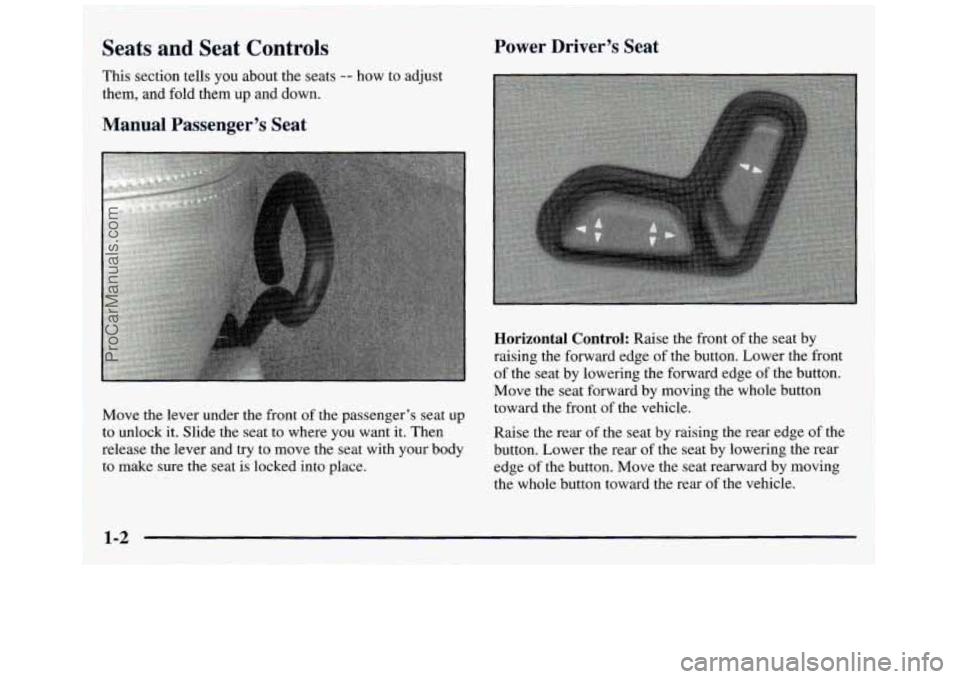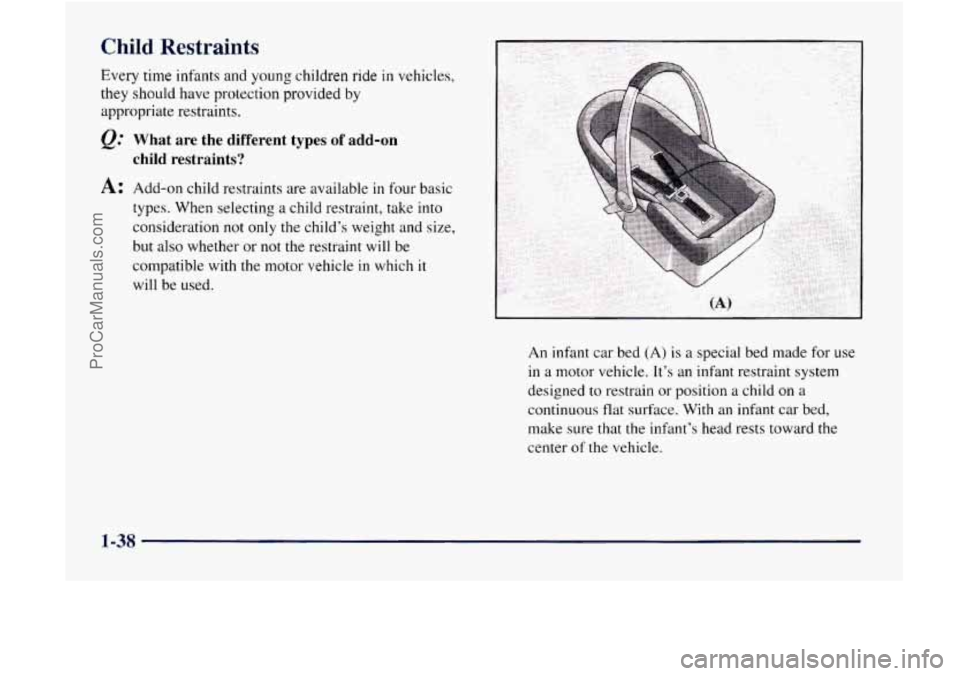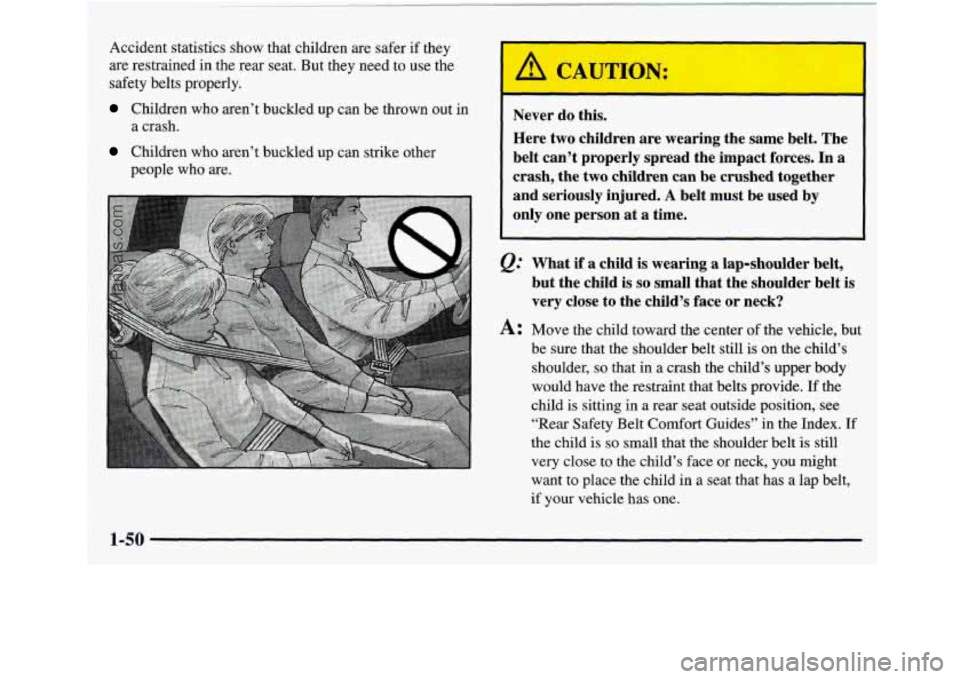1998 GMC ENVOY tow
[x] Cancel search: towPage 9 of 386

Seats and Seat Controls
This section tells you about the seats -- how to adjust
them, and fold them
up and down.
Power Driver’s Seat
Manual Passenger’s Seat
Move the lever under the front of the passenger’s seat up
to unlock
it. Slide the seat to where you want it. Then
release the lever and try to move the seat with your body
to make sure the seat is locked into place.
Horizontal Control: Raise the front of the seat by
raising the forward edge of the button. Lower the front
of the seat by lowering the forward edge of the button.
Move the seat forward by moving the whole button
toward the front
of the vehicle.
Raise the rear of the seat by raising the rear edge of the
button. Lower the rear of the seat
by lowering the rear
edge of the button. Move the seat rearward by moving
the whole button toward the rear of the vehicle.
1-2
ProCarManuals.com
Page 10 of 386

Moving the whole button up or down raises or lowers
the whole seat. Heated Front Seats
Vertical Control: Move the reclining front seatback
rearward by moving the button toward the rear
of the
vehicle. Move the seatback forward by moving the
button toward the front of
the vehicle.
Power Lumbar Control
This control is located on
the side
of the seat. This
feature
will quickly heat the
lower cushion and lower
back of the driver and
front passenger seats for
added comfort.
This control is located on
the side of the seat facing
the door.
Press the lower part
of the switch to turn the heater on
low. Press
the upper part of the switch to turn the heater
on high. Put
the switch in the center position to turn
the heater off. The seatbelt must be latched to activate
this feature.
Press and hold the front
of the control until you have the
desired lumbar support.
To decrease lumbar support,
press and hold the rear
of the control.
1-3
I
ProCarManuals.com
Page 32 of 386

What makes an air bag inflate?
In an impact of sufficient severity, the air bag sensing
system detects that the vehicle is in a crash. The sensing
system triggers
a release of gas from the inflator, which
inflates the air bag.
The inflator, air bag and related
hardware are all part of the air bag modules inside the
steering wheel and in the instrument panel in front
of the
right front passenger.
How does an air bag restrain?
In moderate to severe frontal or near-frontal collisions,
even belted occupants can contact the steering wheel or
the instrument panel. Air bags supplement the protection
provided
by safety belts. Air bags distribute the force of
the impact more evenly over the occupant’s upper body,
stopping the occupant more gradually. But air bags
would not help
you in many types of collisions,
including rollovers, rear impacts and side impacts,
primarily because an occupant’s motion
is not toward
those air bags. Air bags should never be regarded as
anything more than a supplement
to safety belts,
and then only
in moderate to severe frontal or
near-frontal collisions.
What will you see after an air bag inflates?
After an air bag inflates, it quickly deflates, so
quickly that some people may not even realize the
air bag inflated. Some components of the air bag
module
-- the steering wheel hub for the driver’s air bag,
or the instrument panel for the right front passenger’s
bag
-- will be hot for a short time. The parts of the bag
that come into contact with you may be warm, but not
too hot
to touch. There will be some smoke and dust
coming from vents
in the deflated air bags. Air bag
inflation doesn’t prevent the driver from seeing or from
being able to steer
the vehicle, nor does it stop people
from leaving
the vehicle.
When an air bag inflates, there is dust in the air.
This dust could cause breathing problems for
people with a history of asthma or other
breathing trouble. To avoid this, everyone in the
vehicle should get out as
soon as it is safe to do so.
If you have breathing problems but can’t get out
of the vehicle after an air bag inflates, then get
fresh air by opening a window or door.
1-25
1
ProCarManuals.com
Page 33 of 386

Air bags are designed to inflate only once. After they
inflate, you’ll need
some new parts for your air bag
system. If you don’t get them, the air bag syste,m
won’t be there to help protect you
in another crash.
A new system will include air bag modules and
possibly other parts. The service manual for your
vehicle covers the need to replace other parts.
Your vehicle is equipped with a diagnostic module,
which records information about the air
bag system,
The module records information about the readiness
of the system, when the sensors are activated and
driver’s safety belt usage at deployment.
Let only qualified technicians work on your air bag
system. Improper service can mean that your air
bag
system won’t work properly. See your dealer
for service.
I NOTICE:
If you damage the covering for the driver’s or the
right front passenger’s air bag, the bag may not
work properly.
You may have to replace the air
bag module in the steering wheel or both the air
bag module and the instrument panel for the
right front passenger’s air bag.
Do not open or
break the air bag coverings.
If your vehicle ever gets into a lot of water -- such as
water up to the carpeting or higher -- or if water enters
your vehicle and soaks the carpet, the air bag controller
can be soaked and ruined. If this ever happens, and then
you start your vehicle, the damage could make the air
bags inflate, even if there’s no crash. You would have to
replace
the air bags as well as the sensors and related
parts.
If your vehicle is ever in a flood, or if it’s exposed
to water that soaks the carpet, you can avoid needless
repair costs
by turning off the vehicle immediately.
Don’t let anyone start the vehicle, even to tow
it, unless
the battery cables are first disconnected.
1-26
ProCarManuals.com
Page 45 of 386

Child Restraints
Every time infants and young children ride in vehicles,
they should have protection provided by
appropriate restraints.
@ What are the different types of add-on
A: Add-on child restraints are available in four basic
types. When selecting
a child restraint, take into
consideration not only the child’s weight and size,
but
also whether or not the restraint will be
compatible with the motor vehicle
in which it
will be used.
child restraints?
An infant car bed (A) is a special bed made for use
in a motor vehicle. It’s an infant restraint system
designed to restrain or position a child on a
continuous flat surface. With an infant car bed,
make sure that the infant’s head rests toward
the
center of the vehicle.
1-38
ProCarManuals.com
Page 57 of 386

Accident statistics show that children are safer if they
are restrained in the rear seat. But they need
to use the
safety belts properly.
Children who aren’t buckled up can be thrown out in
a crash.
Children who aren’t buckled up can strike other
people who
are.
Never do this.
Here two children are wearing the same belt. The
belt can’t properly spread the impact forces.
In a
crash, the two children can be crushed together
and seriously injured.
A belt must be used by
only one person at a time.
What if
a child is wearing a lap-shoulder belt,
but the child is
so small that the shoulder belt is
very close to the child’s face or neck?
A: Move the child toward the center of the vehicle, but
be sure that the shoulder belt still is on the child’s
shoulder,
so that in a crash the child’s upper body
would have the restraint that belts provide. If the
child is sitting in a rear seat outside position, see
“Rear Safety Belt Comfort Guides’’ in the Index.
If
the child is so small that the shoulder belt is still
very close
to the child’s face or neck, you might
want to place the child in a seat that has a lap belt,
if your vehicle has one.
1-50
ProCarManuals.com
Page 74 of 386

During normal operation, the SECURITY light will go
off after the engine is started.
If the engine stalls and the SECURITY light flashes,
wait about
10 minutes until the light stops flashing
before trying to restart the engine. Remember to release
the key from the
START position as soon as the
engine starts.
If the engine does not start after three (3) tries, the
vehicle needs service.
If you are driving and the SECURITY light comes on,
you will be able to restart the engine if you turn the
engine
off. However, your Passlock system is not
working properly and
must be serviced by your dealer.
Your vehicle is not protected by Passlock at this time.
You may also want to check the fuse (see ”FLIS~S and
Circuit Breakers”
in the Index). See your dealer
for service.
If the SECURITY light comes on while the engine is
running.
a problem has been detected and the system
may need service. See your dealer for service.
In an emergency, call the GMC Roadside Assistance
Center
at 1 -800-GMC-8782 (in Canada, call
1-800-268-6800).
New Vehicle “Break-In”
NOTICE:
~~~ ~ ~
Your vehicle doesn’t need an elaborate
“break-in.” But it will perform better in the long
run if you follow these guidelines:
0
0
0
0
Keep your speed at 55 mph (88 kmh) or
less for the first
500 miles (805 km).
Don’t drive at any one speed
-- fast or
slow -- for the first 500 miles (805 km).
Don’t make full-throttle starts.
Avoid making hard stops for the first
200
miles (322 km) or so. During this time your
new brake linings aren’t yet broken in.
Hard stops with new linings can mean
premature wear and earlier replacement.
Follow this breaking-in guideline every
time you get new brake linings.
Don’t tow a trailer during break-in.
See “Towing a Trailer” in the Index for
more information.
2-13
ProCarManuals.com
Page 75 of 386

Ignition Positions
Use the key to turn the ignition switch to
five different positions.
C
ACCESSORY (A): This position lets you use things
like the radio and
the windshield wipers when the
engine is
off. Push in the key and turn it toward you.
Your steering wheel will remain locked, just as it was
before you inserted the key.
I NOTICE:
Don’t operate accessories in the ACCESSORY
position for long periods
of time. Prolonged
operation
of accessories in the ACCESSORY
position could drain your battery and prevent
you from starting your vehicle.
LOCK
(B): This position locks your ignition, steering
wheel and transmission.
It’s a theft-deterrent feature.
You will only be able to remove your key when the
ignition is turned to LOCK.
OFF (C): This position lets you turn off the engine but
still turn the steering wheel. Use
OFF if you must have
your vehicle in motion while the engine is off (for
example, if your vehicle is being towed).
RUN (D): This is the position for driving.
START (E): This position starts your engine.
2-14
ProCarManuals.com